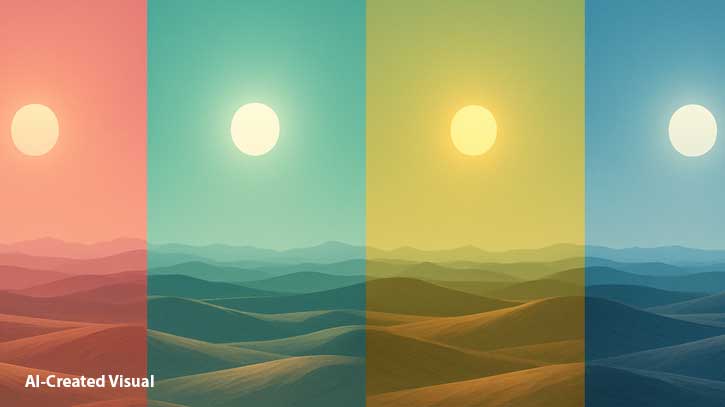Can the sky ever appear pink or green? As strange as it sounds, skies beyond Earth—and even outside our solar system—don’t always look blue. The color of a planet’s sky depends entirely on its atmosphere. Let’s take a virtual tour of our solar system and explore how the skies might appear if you were standing on each planet.
sky colors on other planets🌑 Mercury
Mercury is the closest planet to the Sun, about 36 million miles away. If you somehow managed to stand on Mercury, the sky would appear pitch black—even during the day. That’s because Mercury has no atmosphere to scatter sunlight. However, the Sun would look three times larger and much brighter than it does from Earth. Without an atmosphere, the sunlight would also be extremely intense.
🌕 Venus
Venus, the second planet from the Sun at around 67 million miles away, does have a thick atmosphere—96% carbon dioxide and about 3.5% nitrogen. The sky here is permanently overcast with clouds made of corrosive sulfuric acid. If you looked up, you’d see a murky yellow-orange sky. The dense atmosphere gives everything a hazy appearance, and the thick cloud cover blocks any direct view of the Sun.
🌍 Earth
On Earth, we see a blue sky because sunlight gets scattered in the atmosphere—particularly the blue wavelengths. The atmosphere also filters out most of the violet and ultraviolet rays, which is why the Sun looks yellow to us. Depending on the time of day, the sky’s color can change—orange or purple at dusk, or a vibrant blue after a fresh rain.
🔴 Mars
The Martian sky offers an unusual reversal of Earth. During the day, it appears dusty orange or pale pink. Mars has a very thin atmosphere filled with iron-rich dust particles that scatter light differently, giving it that rosy hue. Interestingly, during sunset, the Martian sky turns a deep blue. The Sun looks smaller and appears white from the Martian surface.
🟤 Jupiter
Jupiter is a gas giant with no solid surface. If you were somehow floating in its atmosphere, the sky would appear deep blue or grey, depending on your altitude. From Jupiter, the Sun would look like a tiny, faint dot in the sky.
🪐 Saturn
On Saturn, the sky appears either deep blue or pale yellowish-grey. Its atmosphere contains ammonia and other gases that scatter sunlight in a unique way, casting a soft yellow tint. The Sun would be just a small, bright speck in Saturn’s sky.
🔵 Uranus
Uranus has a beautiful light cyan or turquoise sky. This comes from methane gas in the atmosphere, which absorbs red light and scatters blue-green light. The Sun, from this icy world, appears as a pale dot far off in the distance.
🔵 Neptune
Neptune’s sky is a rich, deep blue. Methane plays a role here too, but additional atmospheric dynamics intensify the color. The Sun, barely visible, provides little light, even during the day.

